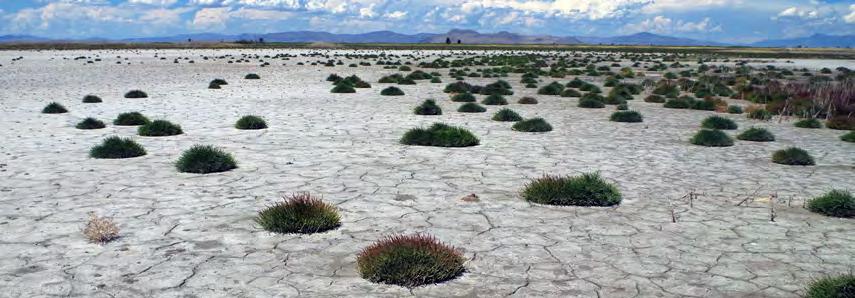
2 minute read
Chapter 4: Playa Wetlands
Playa Wetlands
Playa means “beach” or “seashore” in Spanish and refers to an arid or semiarid wetland with distinct wet and dry seasons.36 Playas comprise approximately 240 km² (60,317 ac) around Great Salt Lake (GSL); in fact, the lake itself is located in a playa depression, which is why it is relatively shallow. GSL playas typically collect water during the spring. When water evaporates, the mineral deposits left behind create highly saline and alkaline soil conditions.39 Playas are sparsely vegetated and occur on poorly drained depressions that typically have no outlet. Because playas are a harsh environment, plants that do occur in playas have physiological adaptations to survive drought, salinity, and high pH. Mudflats are areas that have become exposed when flooded submergent or emergent wetlands have been drawn down. GSL mudflats cover approximately 1,680 km² (414,689 ac) and are considered critical habitat for millions of migratory shorebirds. During periods of drought, large portions of the bed of GSL itself are also exposed and classified as mudflats.55 Because plant species found in playas also occur on mudflats, this section combines facts about playas with facts about mudflats.
Plants
Despite their simple vegetation structure, playas and mudflats are difficult to manage and tend to be maintained passively. Playa vegetation requires both brief, seasonal flooding and extended drought. Plants that grow in playas, such as pickleweed (Salicornia rubra, p. 124) and Pursh seepweed
(Suaeda calceoliformis, p. 125), are typically short and sparse. Pickleweed is a halophyte (salt-loving plant) capable of growing in soils with a salinity of 35 ppt or greater. The leaves of pickleweed have been reduced to scales, while the stems are succulent and include vacuoles or chambers that sequester salts from the rest of the plant. The seeds of pickleweed are dehiscent, which means they are forcefully expelled from plants as they dry out during the late fall, attracting large flocks of waterfowl.12 Pursh seepweed, another succulent halophyte, is taller than pickleweed and grows in both saline and brackish wetlands. Like pickleweed, Pursh seepweed produces more seeds when exposed to saline and alkaline conditions. In GSL playas, Pursh seepweed is important because it provides cover for nesting shorebirds.42 Other plants, such as phragmites (Phragmites australis, p. 50) and saltgrass (Distichilis spicata, p. 97) grow well in playas. Phragmites, an aggressive wetland invader, can quickly colonize playa ecosystems through seeds and by sending out stolons and rhizomes. Dense, invasive phragmites that grows on previously unvegetated ground completely alters the habitat, preventing birds that need open foraging areas from accessing their prey.10 Although saltgrass is primarily a salt meadow species, it is prevalent in playas as well.





